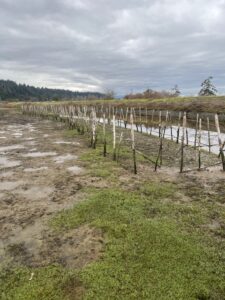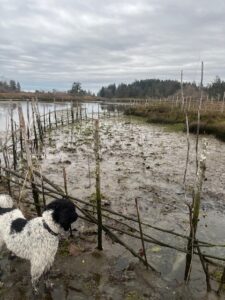The subject of study:
I have decided to study whether or not “geese-free enclosures” are benefiting estuarine grasses recover from over-grazing.
Field observations:
- Location: Little Qualicum River Estuary
- Date: Thursday, Nov 21, 2024
- Weather: Partly cloudy, 9 degrees
- Multiple large herbivorous bird species were observed in the estuary including Canada Geese (Branta Canadensis), Trumpeter Swan (Cygnus Buccinator), Mallard Duck (Anas Platyrhynchos)
Observations:
Enclosures:
Enclosures are large fenced areas in the salt marsh flats of the Little Qualicum river estuary. These fences are made from woven branches and driftwood, forming a makeshift pasture for vegetation regeneration.
- Location 1: Located in a side channel close to the spit. The elevation is approximately 3.5m above sea level
- Location 2: Located approximately 150m upstream of location #1. Still on the same tidal flat, the elevation is considered very comparable to the 3.5m of site #1
Control:
I will select control areas based on 3 factors. Elevation will be a key factor as species composition changes significantly when exposed to fewer high-water events. Proximity to enclosures may also be an influencing factor as geese prefer to have unobstructed views of their surroundings and enclosures pose obstructions for take-offs too. Therefore control plots will be selected a minimum of 10m away from enclosures.
- Location 1: A randomized location will be selected
- Location 2: A randomized location will be selected
Hypothesis: Geese-free enclosures aid estuarine grass species’ abundance and diversity by giving them rest from overgrazing.
Prediction: A strong positive correlation between abundance and diversity inside the enclosed versus outside it.
Response variable: Estuarine grass diversity and abundance
Explanatory variable: If the fence is working to keep large herbivorous birds out

